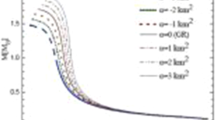Abstract
IN the standard model for type Ia supernovae1, a massive white dwarf in a binary system accretes matter from the companion star until it reaches the Chandrasekhar mass (the stability limit for degenerate-electron stars, corresponding to ∼1.4 solar masses), and a runaway thermonuclear explosion ensues. In a popular variant of this model2, the companion star is also a white dwarf. But regardless of the nature of the companion, the invariance of the Chandrasekhar mass implies that all type Ia supernovae will be similar in luminosity3, making them ideal 'standard candles' for determining extragalactic distances, and hence the Hubble constant. In the context of the standard model, the recent type Ia supernova SN1991bg is hard to explain: it was underluminous at all observed epochs, leading to suggestions4,5 that the mass of the progenitor was unusually low. Here we present model calculations, based on more recent spectra, which point to a mass of the white dwarf of ∼0.7 solar masses―well below the Chandrasekhar mass. Moreover, the late spectrum shows evidence of emission from low-velocity hydrogen gas, which might originate in material stripped from an extended, hydrogen-rich companion star. If our interpretation is correct, SN1991bg challenges both the double white-dwarf scenario, and the standard model for type Ia supernovae.
Similar content being viewed by others
References
Woosley, S. E. & Weaver, T. A. A. Rev. Astr. Astrophys. 24, 205–253 (1986).
Iben, I., Jr., & Tutukov, A. V. Astrophys. J. Suppl. 54, 335–372 (1984).
Branch, D. & Tammann, G. A. A. Rev. Astr. Astrophys. 30, 359–389 (1992).
Filippenko, A. V. et al. Astr. J. 104, 1543–1556 (1992).
Leibundgut, B. et al. Astr. J. 105, 301–313 (1993).
Wheeler, J. C. & Harkness, R. P. Rep. Prog. Phys. 53, 1467–1557 (1990).
Ruiz-Lapuente, P. & Filippenko, A. V. in Origin and Evolution of the Elements (eds Prantzos, N., Vangioni-Flam, E. & Cassé, M.) 318–322 (Cambridge Univ. Press, 1993).
Munari, U. & Renzini, A. Astrophys. J. 397, L87–L90 (1992).
Robinson, E. L. & Shafter, A. W. Astrophys. J. 322, 296–301 (1987).
Bragaglia, A., Greggio, L., Renzini, A. & D'Odorico, S. Astrophys. J. 365, L13–L17 (1990).
Foss, D., Wade, R. A. & Green, R. F. Astrophys. J. 374, 281–287 (1991).
Whelan, J. & Iben, I. Jr. Astrophys. J. 186, 1007–1014 (1973).
Kenyon, S. J., Livio, M., Mikolajewska, J. & Tout, C. A. Astrophys. J. 407, L81–L84 (1993).
Woosley, S. E. & Weaver, T. A. Astrophys. J. (submitted).
Livne, E. Astrophys. J. 354, L53–L56 (1990).
Livne, E. & Glasner, A. S. Astrophys. J. 370, 272–281 (1991).
Chugai, N. Soviet Astr. 30, 563–567 (1986).
Livne, E., Tuchman, Y. Wheeler, J. C. Astrophys. J. 399, 665–671 (1992).
Phillips, M. M. et al. Publs Astr. Soc. Pacif. 99, 592–605 (1987).
Canal, R., Isern, J., & Labay, J. Astrophys. J. 398, L49–L52 (1992).
Burbidge, E. M. & Burbidge, G. R. Astrophys. J. 142, 634–640 (1965).
Hansen, L., Nørgaard-Nielsen, H. u. & Jørgesen, H. E. Astr. Astrophys. 149, 442–448 (1985).
Jeffery, D. J., et al. Astrophys. J. 397, 304–328 (1992).
Kirshner, R. P. et al. Astrophys. J. (in the press).
Ruiz-Lapuente, P. & Lucy, L. B. Astrophys. J. 400, 127–137 (1992).
Phillips, M. M. Astrophys. J. 413, L105–L108 (1993).
Weidemann, V. & Koester, D. Astr. Astrophys. 132, 195–202 (1984).
Filippenko, A. V. et al. Astrophys. J. 384, L15–L18 (1992).
Ruiz-Lapuente, P., et al. Astrophys. J. 387, L33–L36 (1992).
Lucy, L. B. Astrophys. J. 383, 308–313 (1991).
Author information
Authors and Affiliations
Rights and permissions
About this article
Cite this article
Ruiz-Lapuente, P., Jeffery, D., Challis, P. et al. A possible low-mass type Ia supernova. Nature 365, 728–730 (1993). https://doi.org/10.1038/365728a0
Received:
Accepted:
Issue Date:
DOI: https://doi.org/10.1038/365728a0
- Springer Nature Limited





